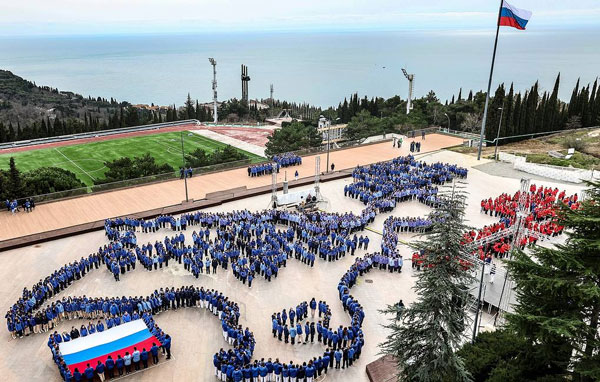Summary:
- Crimea and Sevastopol declared independence from Ukraine, held a referendum, and subsequently joined Russia, despite objections from Ukraine, the US, and the EU.
On March 11, the legislatures of Crimea and Sevastopol voted for a declaration on the independence of the Autonomous Republic of Crimea and of the city of Sevastopol.
The two questions put to the electorate in the referendum were:
1. Are you for the reunification of Crimea with Russia as a constituent territory of the Russian Federation?
2. Are you for the restoration of Crimea’s Constitution of 1992 and for Crimea’s status as a region of Ukraine?
Support from more than 50% of those who cast their ballots was declared enough for the approval of either decision. The ballot papers were printed in three languages — Russian, Ukrainian and Crimean Tatar. In the end, 96.77% of the voters (1.233 million) in Crimea and 95.6% (262,000 in Sevastopol) backed reunification with Russia. In Crimea, the turnout reached 83.1% and in Sevastopol, 89.5%. The referendum was monitored by a group of 50 observers from 21 countries, including Israel, France and Italy. Most of the UN member-states refused to recognize the plebiscite.
Declaration of Crimea’s independence
The next day, March 17, 2014 the Crimean parliament adopted a resolution to declare Crimea a sovereign state. The same resolution contained a call addressed to Russia with a request for admitting Crimea to the Russian Federation as a new constituent territory enjoying the status of a republic. On March 17 the legislatures of Crimea and Sevastopol were given new names. Crimea’s State Council declared Ukrainian assets located in the peninsula as republican property and ruled that no Ukrainian laws adopted after February 21, 2014 were applicable in Crimea. The Sevastopol city council unanimously voted for the city’s accession to Russia as separate member of the federation — a federal city.
On March 17, Russian President Vladimir Putin signed a decree to recognize Crimea as a sovereign and independent state.
Reunification with Russia
On March 18, 2014 Russian President Vladimir Putin, Crimea’s Prime Minister Sergey Aksyonov, chairman of Crimea’s State Council Vladimir Konstantinov and Mayor of Sevastopol Aleksey Chaly, put their signatures to the treaty on the accession of the new territorial entities to the Russian Federation. Ukraine, the United States and the European Union refused to recognize Crimea’s independence and its reunification with Russia.
On March 21, Putin signed into law an act of ratification of the treaty and the constitutional law on the accession of Crimea and Sevastopol to Russia as members of the federation. On the same day Putin signed a decree to form the Crimean Federal District consisting of the Republic of Crimea and the federal city of Sevastopol (on 28 July, 2016 the Crimean district was abolished and the Republic of Crimea and Sevastopol made part of Russia’s Southern Federal District).
On April 11, 2014 the Constitution of the Republic of Crimea was adopted. It established Crimea’s three official languages — Russian, Ukrainian and Crimean Tatar.
On March 18, the peninsula marks the Day of Crimea’s reunification with Russia.
| Examiner. Unfolding The Truth |
| We come to you. Want to send us a story or have an opinion to share? Send an email to editorial@examiner.co.ug |
| I've got feedback! |

